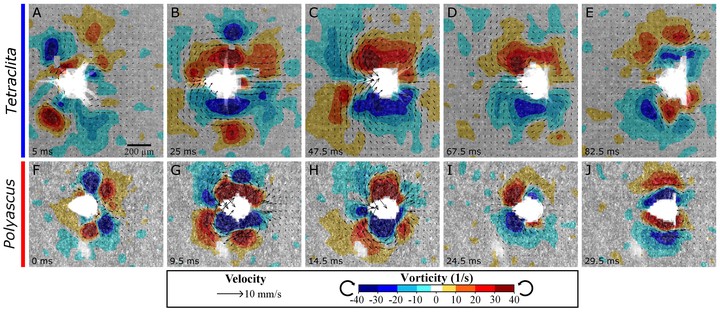Evolution of feeding shapes swimming kinematics of barnacle naupliar larvae: a comparison between trophic modes

Abstract
A central goal in evolutionary biology is connecting morphological features with ecological functions. For marine invertebrate larvae, appendage movement determines locomotion, feeding, and predator avoidance ability. Barnacle larvae are morphologically diverse, and the morphology of non-feeding lecithotrophic nauplii are distinct from those that are planktotrophic. Lecithotrophic larvae have a more globular body shape and simplified appendages when compared to planktotrophs. However, little is known about whether and how such morphological changes affect kinematics, hydrodynamics, and ecological functions. Here, we compared the nauplii kinematics and hydrodynamics of a lecithotrophic Rhizocephalan species, Polyascus planus, against that of the planktotrophic nauplii of an intertidal barnacle, Tetraclita japonica. High-speed, micro-Particle Image Velocimetry analysis showed that the Polyascus nauplii swam faster and had higher amplitude and more synchronous appendage beating than the Tetraclita nauplii. This fast swimming was accompanied by a faster attenuation of induced flow with distance, suggesting reduced predation risk. Tetraclita nauplii had more efficient per beat cycles with less backward displacement during the recovery stroke. This “anchoring effect” resulted from the anti-phase beating of appendages. This movement, together with a high-drag body form, likely helps direct the suction flow towards the ventral food capturing area. In sum, the tradeoff between swimming speed and predation risks may have been an important factor in the evolution of the observed larval forms.
Supplementary Videos
Video S1
High speed video of swimming barnacle nauplii at 100× slow motion. Top, nauplius of common intertidal barnacle, Tetraclita japonica; bottom, nauplius of the parasitic Rhizocephalan barnacle, Polyascus planus
Video S2
Kinematics analysis on appendage movements of the planktotrophic Tetraclita nauplius
Video S3
Kinematics analysis on appendage movements of the lecithotrophic Polyascus nauplius
Video S4
Velocity and vorticity fields around swimming nauplii from dorsal view (100× slow motion)
Video S5
Velocity and vorticity fields around swimming nauplii from lateral view (100× slow motion)
Video S6
Animation of particle tracking during recovery strokes from side view (200× slow motion)